The Pane Issues
Resolving Issues with the macOS Software Update Feature
Under specific circumstances, which depend on your local network, your Internet service provider, and the country you are in, the software update feature of macOS might not always work as error-free as expected. TinkerTool System can help you to resolve typical problems with single mouse-clicks.
What is macOS Software Update?
macOS uses two completely separate technical features to keep software products up-to-date: The operating system itself and additional components which can be seen as parts or add-ons of the operating system are updated via a function called macOS Software Update. It is based on a newsfeed-like architecture which informs macOS about available downloads. If you participate in one of the beta software programs offered by Apple, the standard feed can be redirected to a different one which contains additional beta products, not available to the general public.
For Apps that have been dowloaded from the Mac App Store, no matter if the Apps have been developed by Apple or by third-party vendors, macOS uses a different mechanism which is linked to the App Store itself. This feature is called App Updates.
App updates are presented in the App Store application, item Updates. On the other hand, macOS software updates are listed in System Settings, pane General > Software Update.
Apple distributes new Macintosh operating systems in form of an App which is in fact the installer for that system. So an upgrade of macOS (switching from your current OS to a new generation OS with a different major version number) comes as App from the App Store, while each update of the OS (product care which only changes the minor version number) comes via the Software Update function.
Reset a Hanging Search for Updates
With several of the macOS updates published by Apple as of 2022, the software update feature may not always work correctly. When you try to search for the latest updates on the pane General > Software Update in System Settings, the progress indicator may begin to rotate endlessly and no actual search is performed. A similar effect occurs when you try to execute the equivalent search command in Terminal. This can be a critical problem, because it blocks the possibility to download important security updates.
TinkerTool System can reset the software update component which will usually resolve this issue immediately. Perform the following steps if your version of macOS is affected by this problem:
- Quit System Settings or the softwareupdate command in Terminal if these programs should be running at the moment.
- In TinkerTool System, open the sub-item Software Update on the pane Issues.
- Click the button Reset Running Operation.
If the reset has been successful, you can immediately start a new attempt to search for macOS updates.
Apple has begun to actively block this feature in all operating system versions published as of March 2024. If you are affected by this, it may only be possible to use this function after you have disabled System Integrity Protection (for instructions, please see the respective section in Basic Operations).
Enforcing an Immediate Synchronization with the List of Available Updates
It can happen that macOS doesn’t notice the availability of an update immediately. There can be a delay of up to two weeks before an entry finally appears on your local system. In case you have learned from somewhere else, like a press article or news web site, that an update must be available which was not automatically listed by your computer yet, you can force your Mac to contact Apple, retrieving the latest list of update downloads available now. To do this, perform the following steps:
- Open the sub-item Software Update on the pane Issues.
- Click the button Synchronize List.
After that, macOS will contact Apple via your Internet connection. TinkerTool System shows a small status panel, indicating live what the operating system is doing. Retrieving and evaluating the up-to-date software list may take several minutes. If new updates are available, System Settings will automatically list them as soon as the synchronization process is completed.

Removing Unsuitable Update Notifications
In some special cases, the opposite of the previously mentioned issue can occur: macOS may list available software updates you are no longer interested in, so you basically have “too many” entries in the list of updates. This can happen shortly after you have changed your personal software feed, for example when you have decided to no longer participate in one of the beta programs. In that particular case, System Settings may still list beta updates although you don’t like to see them any longer.
To clear the list of available updates in such a case, perform the following steps:
- Open the sub-item Software Update on the pane Issues.
- Click the button Clear Update Catalog.
Check the Presence of a Cache Server
If you have many Apple devices on your local network, setting up a content caching server on your network can greatly speed up access to updates. All you have to do is turn on the corresponding function on a Mac in your network that is running as continuously as possible. This server monitors the data traffic for updates and caches all downloaded data. The other computers on the network detect the presence of the content caching server and can now download updates from it over a fast local line. The update data no longer has to be downloaded again for each computer via the slower Internet connection. If desired, the content caching server can also accelerate read and write access to iCloud services by also caching data locally for this purpose. Multiple content caching servers can be deployed simultaneously for very large networks.
All aspects of a content caching server are fully automated. After turning on the service on the computer that was selected for this purpose and selecting the options, which and how much data should be cached, no further actions are required. Clients do not have to be set up, but use the service automatically as soon as it is available.
For certain combinations of operating system versions of the clients and the operating system version of the server, however, there are known errors in macOS in which the search for updates does not work correctly, or certain update packages are not offered at all or are offered very late. Therefore, when troubleshooting software update issues, it is necessary to know if there are one or more content caching servers on the network. This is not always clear. For example, a mobile Mac user might have accidentally (or even maliciously) turned on the content caching server feature, causing problems when this Mac is present in the local network.
The program can check whether there are content caching servers on the local network and which of them is currently the preferred one used by your Mac to retrieve updates. The IP addresses of a server and the list of detail services offered by the cache can also be determined.
- Open the sub-item Software Update on the pane Issues.
- Click the button Search Cache Server.
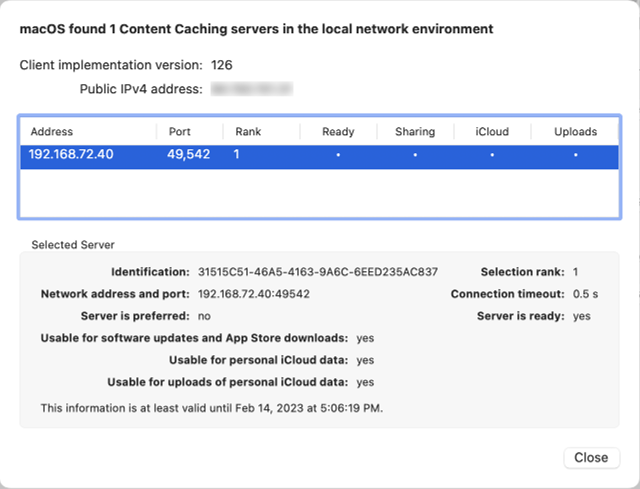
If one or more servers are available, they will be listed in a separate sheet. The window contains the following data:
- Client implementation version: the version number of the software that the currently running version of macOS uses when working with content caching
- Public IPv4 Address: the network address currently used by the client when accessing the Internet
A table lists all local content caching servers with a brief description. After selecting a line, the details for each server appear in the lower part of the window:
- Identification: a UUID that uniquely identifies each server worldwide
- Network address and port: the IPv4 address of the server in the local network and the port number for accessing the cache service
- Server is preferred: a flag indicating whether this server should be preferred over other existing servers
- Selection rank: the priority used to select this server if there are multiple servers in the network
- Connection timeout: the time after which an access attempt will be aborted
- Server is ready: a status indication of whether this server is currently operational
- Usable for software updates and App Store downloads: a status indication of whether this server caches software updates and app updates
- Usable for personal iCloud data: a status indication whether this server can be used to read iCloud data from users in the local network
- Usable for uploads of personal iCloud data: a status indication whether this server can be used for writing iCloud data by users in the local network
In addition, information is given as to when this Mac considers the specified data to be valid. At this point in time at the latest, the information will be refreshed again.
App Store Update
The App Store application introduces an annoying problem as of macOS Big Sur where users receive update notifications for Apps they have updated already, sometimes several months ago. This can happen if you are using your Mac with multiple users and only one of them usually downloads updates for Apps, or if you have multiple Macs and use the App Store on only on one of them, then copying the Apps manually to the others.
A reset of the App Store information for the affected user should usually fix this problem. TinkerTool System offers you to reset either the current user account or all active user accounts of the Mac. In this context, an “active” account refers to a user who has a home folder at the default location on the local Mac (usually in the folder /Users).
The reset operation will also clear the overview page of the App Store that lists the recent updates this user has downloaded. The list of purchases or any other data for the user who might currently be logged into the App Store won’t be affected, however.
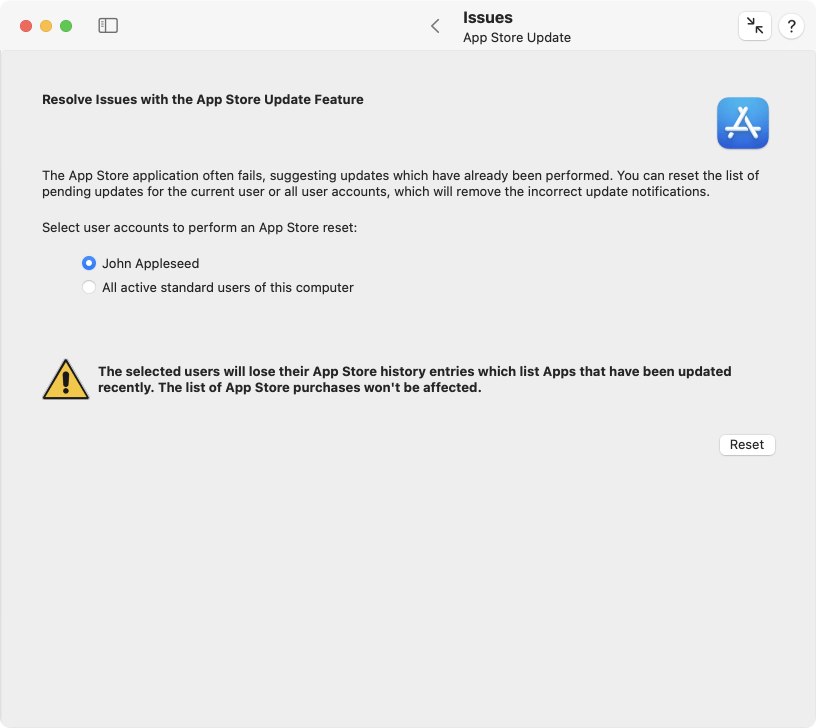
To reset the App Store application, perform the following steps:
- Open the sub-item App Store Update on the pane Issues.
- Use the buttons at Select user accounts to perform an App Store reset to choose whether you like to run the reset for the current user or for all users of this Mac.
- Click the button Reset.
You should quit the App Store application before you run the reset operation, and you should also make sure that no downloads or updates from the App Store are currently running in the background.
Xcode Keychains
If you have tried to use the feature of Xcode to import or export your protected personal developer data, i.e. the Apple ID together with the associated security certificates for digitally signing applications and installers, for example to transfer them to a second computer running Xcode, you will have noticed an erroneous behavior of the application Keychain Access afterwards:
- One or more keychains with the name pattern accountsKeychain… are listed in the program. These keychains can neither be used, nor be deleted.
- Depending on the version of macOS, the Keychain Access applications runs significantly slower when performing specific features.

The affected features of Xcode are called Export or Import Apple ID and Code Signing Assets, respectively. TinkerTool System can check whether these functions have triggered the mentioned error in Keychain Access. In this case, a single mouse click will be sufficient to resolve this problem automatically. The invalid keychains will be deleted:
- Open the sub-item Xcode Keychains on the pane Issues.
- Click the button Remove Invalid Keychains.
Background Items
With macOS 13 Ventura, Apple has integrated a strongly revised version of system service management into the operating system. The most important change is that helper programs that provide services for “big” applications no longer have to be placed in central folders of the operating system (such as /Library/PrivilegedHelperTools/ for privileged utilities). Instead they can remain in their associated main programs. This has the advantage that nothing needs to be installed or uninstalled for new applications. Once the main application has been copied to the Mac, its embedded utility is automatically present with no special setup required. If the program is later deleted, the embedded helper program is automatically removed as well. To do this, macOS must monitor in the background whether the existing applications contain helper programs that can provide services. The type of each service can be determined based on description files that are hidden in the main program.
Both, new helper programs and old ones, that still want to be compatible with operating systems prior to macOS 13 and therefore cannot use the modern way of embedding in the main application yet, are called Background Items by Apple. All detected helper programs are listed on the pane Login Items of System Settings, under the heading Allow in the Background.
Unfortunately, the new term “background item” and the way it is presented is very confusing. Users get the false impression that the listed items are programs that macOS would always start automatically. Additionally, the brief explanation given on the pane Login Items provides a similar, incorrect definition.
In reality, “background items” are just permissions granted to macOS to potentially start a helper program in case the main application would request its services. In some cases, this can mean that a helper program is indeed started automatically by macOS every time the system starts, namely when this makes sense due to the functions of the helper program. But it can just as well mean that a utility is never started, e.g. because the user does not need its services at all. The associated main application specifies the conditions under which a helper program is to be started via an internal definition file.
In addition to the misleading description of what a background item actually is, the new service management in macOS Ventura is anything but correct and reliable. There are a large number of internal defects and general design flaws. Among other things, there are the following problems:
- The name of an item is often determined incorrectly and displayed in different ways for different users.
- The associated main application of a background item cannot always be determined.
- In some cases, items are grouped under the name of the software developer for whom Apple has notarized one of the associated main applications. This doesn’t make sense, since the user can no longer validate and turn off items individually.
- In many cases, the name of the software developer cannot be determined.
- In many cases, the name of a software developer does not allow the user to deduce which application it belongs to.
- In some cases, a main application calls a utility that is included with macOS. System Settings is unable to indicate “Apple” as a developer.
- It is not clearly distinguished whether the name of the helper program or rather the name of the associated main application is shown.
- A button with an info icon is displayed in some cases, designed to determine the location of a helper program. This button often has no function.
- In cases where indicating the storage location actually works, the user may be tempted into simply deleting the helper. However, deleting it can cause significant damage in the system.
- The notification that a newly added background item should be approved often appears far too late. Sometimes it only appears after restarting the computer.
- Users that have network accounts instead of local accounts cannot approve background items.
- Even if a user approves a background item, macOS often does not start the associated helper, ignoring that the main application may urgently need it. A restart of the computer is required.
- In some cases, approving a background item doesn’t work permanently. After each restart of the computer, the user will again receive requests to add already granted background items, often with dozens of notifications.
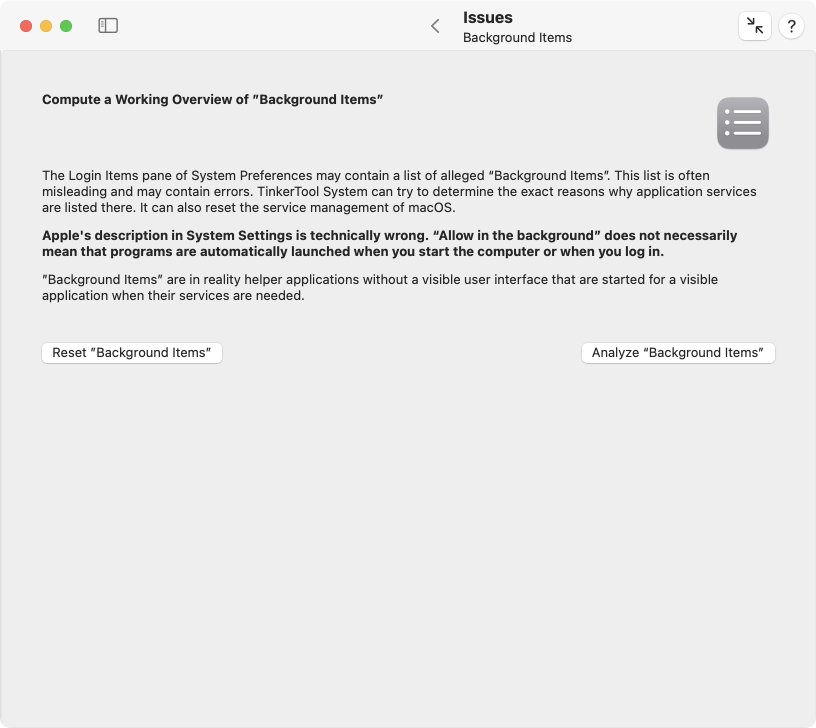
Of course, TinkerTool System cannot really fix the many errors and design flaws that occur in different ways in the different versions of macOS 13, but it can provide two features that offer good workarounds in practice:
On the one hand, you can force macOS to delete the entire service management data for background items, to have it rebuilt with the current system version. Some deficiencies are then rectified for some time. On the other hand, you can have TinkerTool System create its own list of background items. It tries to take the list from macOS, but display it in an error-free way. This can help to understand why macOS considers a particular program a background item and what is actually meant by the often dubious entries in System Settings.
As explained above, background items are actually user preferences that control which helper programs are allowed to be launched on demand for your user account. The list of background items can therefore be different for each user.
Perform the following steps to reset the service management for background items in macOS:
- Make sure you can restart the computer.
- Open the sub-item Background Items on the pane Issues.
- Click the button Reset “Background Items”.
- Follow the program’s instructions. TinkerTool System will restart the computer.
- Log back into the computer using the same user account.
- TinkerTool System will automatically restart and confirm that the reset is complete.
Perform the following steps to have TinkerTool System analyze the list of background items. The program will then display a similar list as error-free as possible. You can compare this list to the list shown by macOS in System Settings.
- Open the sub-item Background Items on the pane Issues.
- Click the button Analyze “Background Items”.
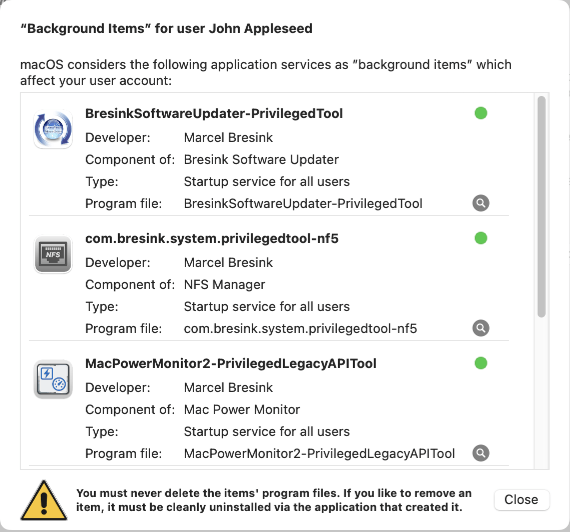
You receive the following information for each entry of a background item:
- an icon and the name under which the item is listed
- a status display, whether the utility can be started on demand (green) or whether you do not allow the start (red)
- Developer: the name of the developer of this program, if it can be determined
- Component of: the name of the main application this helper program probably belongs to. For older software which has not been adapted to macOS 13 or higher yet, it is technically not possible to determine this exactly in every case.
- Type: the type of helper being launched (see below)
- Program file: the actual filename of the helper program being launched
- a button to reveal the program file in the Finder
TinkerTool System distinguishes between the following types of background items:
- Startup service for all users: the helper is allowed to be started if necessary once macOS has booted
- Login service for all users: the helper is allowed to be started if necessary once any user has logged into macOS
- Login service for you: the helper is allowed to be started if necessary once your own user account has logged into macOS
- Embedded startup service: the utility resides in the main application and is allowed to be started if necessary once macOS has booted
- Embedded login service: the utility resides in the main application and is allowed to be started if necessary once any user has logged into macOS
- Embedded hidden login item: the utility resides in the main application and will be launched in any case once your own user account has logged into macOS. It is similar to a login item, but it is set up by the associated main application and not via visible user settings.
If you do not know the exact purpose of a background item, it is not recommended to block the start in System Settings. This corresponds to the behavior of all macOS versions prior to version 13. Some main applications can no longer work if you block their helper programs.
Warning: You must never delete a background item’s program file. In case of embedded helper programs, this would destroy the main application. With older services, this can result in macOS searching for the missing program every 10 seconds. This permanently leads to numerous log entries and performance problems. If you really want to delete an entry for a background item, you will have to validate in the list (at component of) which main application it belongs to. In the documentation for the main application, you will usually find information on how to cleanly uninstall either just the helper program or the complete software (main application and helper program) from the computer.
Fix Problems with Automatic Time Synchronization
There is a known design flaw in newer versions of macOS: If the Mac is switched off without shutting the operating system down correctly, which can, for example, happen in the event of a power failure or, in the case of portable Macs, if the battery is empty, date and time settings may be wrong the next time the computer is switched on again, but they can also no longer be set correctly. In this special case, macOS repeatedly changes the date and time to incorrect values. This can lead to significant additional problems when communicating with other computers on the network or logging in to user accounts.
You should check first whether the system settings for automatic time synchronization are correct.
- Open the sub-item Time on the pane Issues.
- Click Show Date & Time Settings.
The corresponding pane in System Settings will open. The normal settings are:
- Set time and date automatically: switched on
- Source: Apple (time.apple.com.)
- Time zone: the timezone valid for your current location
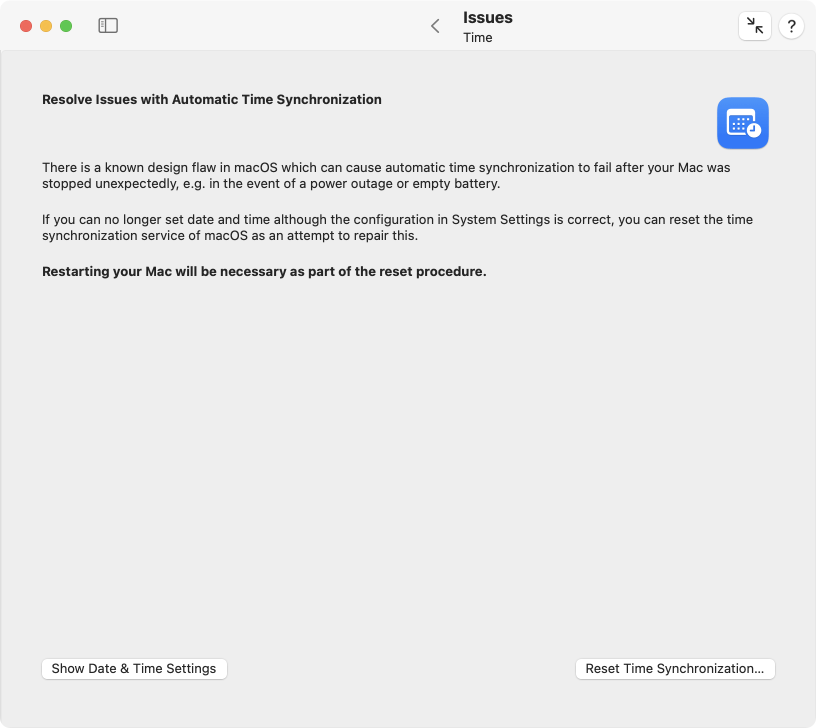
If all settings are correct, but time and date are still wrong, you can try to have TinkerTool System fix this problem by resetting the macOS time synchronization service and deleting incorrect data. Note that this process requires restarting the computer. To attempt repair, follow these steps:
- Open the sub-item Time on the pane Issues.
- Click Reset Time Synchronization….
- Follow the instructions given by the application.
Adding Color Tags on Network Servers
Since the introduction of macOS 13 Ventura (released in 2022), the Finder shows a critical defect: when trying to set a tag for an object stored on a file server in a network, it usually doesn’t work. This applies regardless of whether the server is another Mac or a computer from a different manufacturer with a foreign operating system. Switching between different network protocols (like SMB or NFS) doesn’t help either. In rare cases where specific server-side mount settings apply to the volume hosting the share, adding tags might occasionally succeed. However, in most cases this simply fails with the following effects:
- The Finder displays an absurd request to try again as an administrator.
- The Finder shows a (false) error message stating that the user lacks access rights to complete the operation.
TinkerTool System can add a color tag to a file or folder without using the Finder, regardless of whether the object is located in a network or not. Once a color tag has been added for an object, the Finder will then behave correctly with respect to that object. You can subsequently add further tags (including those without colors) to the same object or remove them using the Finder.
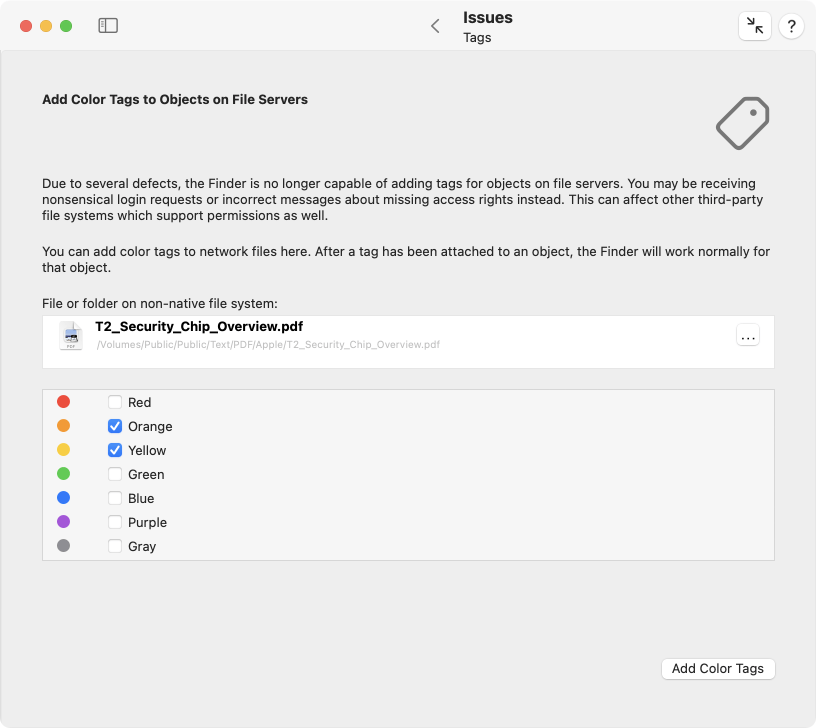
- Open the sub-item Tags on the pane Issues.
- Drag a file or folder from the Finder into the field File or folder on non-native file system. You can also click the button […] to navigate to the object, or click on the white area to enter the UNIX path of the object.
- Add check marks for the desired tags, or remove them respectively.
- Click on Add Color Tags.
Please note the following:
- You can color-tag any objects in the file system, including files, folders, and file-like entries.
- You must have write and read permissions for the folder that contains the affected object. In addition, you need read permission for all attributes of the object. If the object is located on a volume that supports Access Control Lists (ACLs) and Extended Attributes, you also need the right “Write Extended Attributes”. It is not necessary to be the owner of the object.
- You can also attach tags to an alias or an alias-like object such as a symbolic link. In this case, the alias receives the tag, not the object that the alias points to.
You can only change color tags. Once you’ve set color tags for an object on a file server, that object is then “fixed” and can usually be edited further using the Finder without errors occurring. This way, you can subsequently add additional non-color tags you defined yourself to the object.
Apple does not officially allow third-party programs like TinkerTool System to access your personal list of used tags. Therefore, only color tags can be used in the program. You can also change the text for a color tag only through the Finder.
Erasing the Partitioning Info of Disks to Resolve Issues with Disk Utility
The application Disk Utility, as shipped with modern versions of macOS, is affected by several technical defects. One of the issues can prevent the reorganization of used disks: Depending on the partitioning scheme and previous contents, Disk Utility may reject or fail to erase a disk, so you cannot use the drive for new purposes. All attempts to remove the previous file systems are unsuccessful. TinkerTool System can help in this case, clearing the partitioning info that causes problems in Disk Utility.
Warning: Clearing the partitioning info means that all file systems on the drive in question become inaccessible. All data in all volumes on that disk will be lost. The disk drive will behave similar to a brand new device.
To prepare the disk for successful reuse in Disk Utility, perform the following steps:
- Open the sub-item Disk Drives on the pane Issues.
- Select the disk that should be cleared with the pop-up button Disk to erase.
- Review the current partitioning layout of the selected disk in the overview at Affected volumes. TinkerTool System shows the layout in hierarchical order as it was detected by macOS. The application tries to indicate the names and sizes of all volumes found which helps you to identify the correct disk. Note that the overview might include invisible system partitions which might not be shown by Disk Utility.
- Click the button Erase Disk….
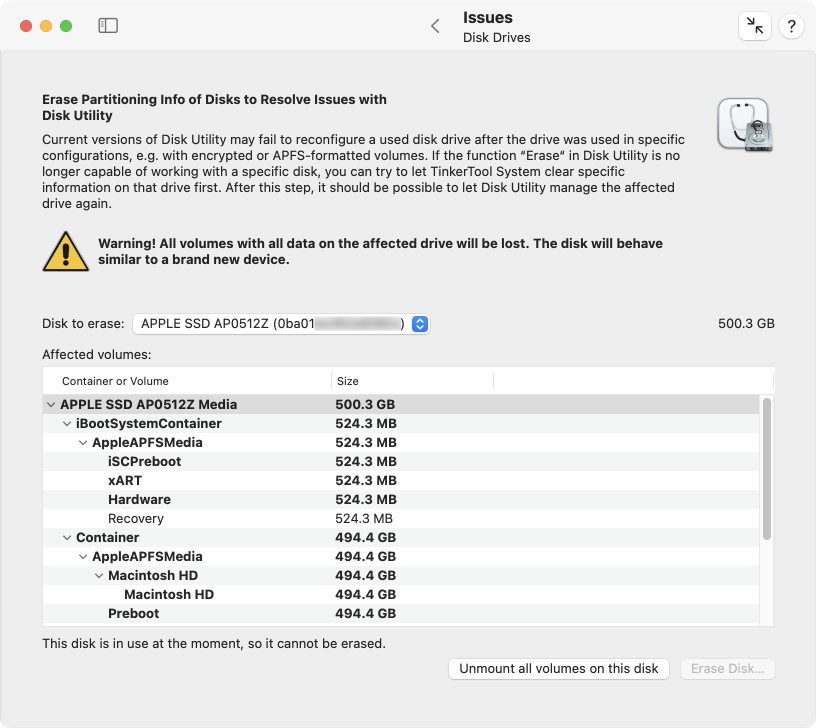
Be absolutely sure that you have selected the correct disk for the clear operation before clicking the Erase button.
The disk itself is shown by its device name, often supplemented by a serial number or bus identification, which can help you to differentiate between similar disks if you have multiple drives of the same model. Volumes which are currently not mounted are inaccessible which means that TinkerTool System may not be able to indicate the volume names to which you are accustomed. Instead, the internal names of the associated partitions may be shown. If you are not completely sure about the identity of a specific disk, try to mount it in Disk Utility to see the volume names in TinkerTool System, then unmount the volumes again.
You can only select a drive for erasure when all of its volumes are inactive. If a disk is still in use, unmount the respective volumes by clicking the button Unmount all volumes on this disk below the table.
After TinkerTool System has successfully performed the clearing procedure, you can try to reuse the drive with Disk Utility, using its own Erase feature which should work correctly now.